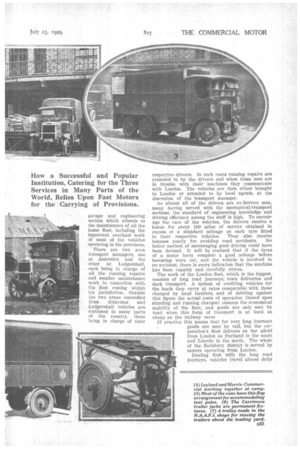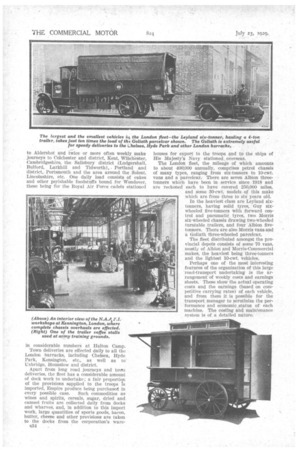CARING for the COMFORT
Page 58

Page 59

Page 60

If you've noticed an error in this article please click here to report it so we can fix it.
of the
BRITISH FIGHTING FORCES
MANY of Our readers are familiar with the huts of the Navy and Army Canteen Board and the Expeditionary Force Canteens which during the war afforded so much comfort a n d good cheer to the British Tommy. It is, however, perhaps not realized that the successor of these wartime organizations now operating under the title of the Navy, Army and Air Force Institutes, is performing a truly remarkable service in catering for the off-duty needs of soldiers, sailors and airmen in many parts of the world.
Transport with this great corporation is, pernaps, the most vital factor of its organization, and, in addition to a home fleet of well over 100 commercial motors covering nearly a million miles yearly, the N.A:A.F.I. operates road-transport vehicles in Iran, Egypt, Palestine, Sudan, Malta, Gibraltar, occupied Germany, China, Jamaica and other parts of the world. The overseas fleet consists mainly of Morris-Commercial one-tonners, although a number of Ford vehicles is still in use. The only country, apart from England, where heavy lorries are used is Germany ; with the army of the Rhine some Albion three-tonuers of the 1828 war type are still doing duty. to from the office in London.
Many of the veincims working abroad have been sent out from England, although of late it has been found more economical generally to purchase lorries from local agents abroad, a policy of employing British-made chassi s, wherever possible, being rigidly adhered to.
The organizing of tae institutes is centralized at Imperial Court, Upper Kennington Lane, London, S.E.11, and close by, at White Hart Street, are warehouses, bakeries, teablending rooms and bacon stoves, as well as a large garage and engineering section which attends to the maintenance of all the home fleet, including the important overhaul work of most of the vehicles operating in the provinces.
There are two area transport managers, one at Aldershot and the other at Ludgershall, each being in charge of all the running repairs and smaller maintenance work in connection with the fleet coming within his jurisdiction. Outside the two areas controlled from Aldershot and Ludgershall vehicles are stationed in many parts of the country, these being in charge of their
respective drivers. In such eases running repairs are attended to by the drivers and when these men are in trouble with their machines they communicate with London. The vehicles are then either brought to London or attended to by local agents, at the discretion of the transport manager.
As almost all of the drivers are ex-Service men, many having served with the mechanical-transport sections, the standard of engineering knowledge and driving efficiency among the staff is high. To encourage the care of the vehicles, the drivers receive a bonus for every 100 miles of service obtained in excess ot a standard mileage on each tyre fitted to their respective vehicles. They also receive bonuses yearly for avoiding road accidents. No
better method of encouraging good driving could have been devised. It will be realized that if the tyres of a motor lorry complete a good mileage before becoming worn out, and the vehicle is involved in no accident, there is every indication that the machine has been capably and carefully driven.
The work of the London fleet, which is the biggest, consists of long road journeys, town deliveries and dock transport. A system of crediting vehicles for the loads they carry at rates comparable with those charged by local hauliers, and of debiting against this figure the actual costs of operation (based upon standing and running charges) ensures the economical stability of the fleet, and goods are only sent by road when this form of transport is at least as cheap as the railway rates practice this means that for very long journeys goods are sent by rail, but the corporation's fleet delivers as far afield from London as Portland in the south and Lincoln in the north. The whole of the Salisbury district is served by motors operating from London.
Dealing first with the long road journeys, vehicles travel almost daily to Aldershot and twice or more often weekly, make journeys to Colchester and district, Kent, Winchester, Cambridgeshire, the Salisbury district (Ludgershall, Bulford, Larkhill and Tidworth), . Portland and district, Portsmouth and the area around the Solent, Lincolnshire, etc. One daily load consists of cakes and other perishable foodstuffs bound for Wemlover, these being for the Royal Air Force cadets stationed in considerable numbers at Halton Camp.
Town deliveries are effected daily to all the London barracks, including Chelsea, Hyde Park, Kensington, etc., as well as to Uxbridge, Hounslow and district.
Apart from long road journeys and tom deliveries, the fleet has a considerable amount of dock work to undertake; a fair proportion of the provisions supplied to the troops N imported, Empire produce being purchased in
every possible case. Such commodities as wines and spirits, cereals, sugar, dried and canned fruits are collected daily from docks and wharves, and, in addition to this import work, large quantities of sports goods, bacon, butter, cheese and other provisions are taken to the docks from the corporation's ware 1334 houses for export to the troops and to the ships of His Majesty's Navy stationed, overseas.
The London fleet, the mileage of which amounts to about 40(1000 annually, comprises petrol chassis of many types, ranging from six-tonners to 10-cwt. vans and a parcelcar. There are seven Albion threetonners which have been in service since 1918 and are reckoned each to have covered 250,000 miles, and some 30-cwt. models of this make .which are from three to six years old.
In the heaviest class are Leyland sixtanners, having solid tyres, • Guy sixwheeled five-tonners with forward control and pneumatic tyres, two Morris six-wheeled chassis drawing two-wheeled turntable trailers, and four Albion fivetanners. There are also Morris vans and a Goliath three-wheeled parcelcar.
The fleet distributed amongst the provincial depots consists of some 70 vans, mostly, of Albion and Morris-Commercial makes, the heaviest being three-tonners and the lightest 10-cwt. vehicles.
Perhaps oneof the most interesting features of the organization of this large 'road-transport undertaking is the arrangement of weekly costs and earnings • sheets. • These show the actual operating costs and the earnings (based on competitive carrying rates) of each vehicle, and from them it is possible for the transport manager to scrutinize the performance and economic status of each machine. The costing and maintenance system is of a detailed nature.




















































































































